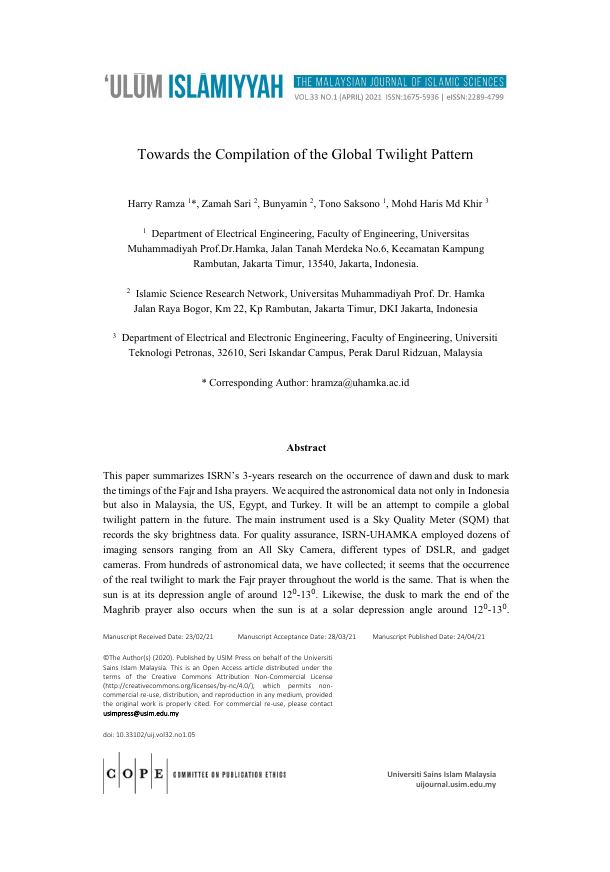Towards the Compilation of the Global Twilight Pattern
DOI:
https://doi.org/10.33102/uij.vol33no1.269Keywords:
global twilight pattern, sun depression angle, sky brightness, polynomial regression model, image processing and analysisAbstract
This paper summarizes ISRN’s 3-years research on the occurrence of dawn and dusk to mark the timings of the Fajr and Isha prayers. We acquired the astronomical data not only in Indonesia but also in Malaysia, the US, Egypt, and Turkey. It will be an attempt to compile a global twilight pattern in the future. The main instrument used is a Sky Quality Meter (SQM) that records the sky brightness data. For quality assurance, ISRN-UHAMKA employed dozens of imaging sensors ranging from an All Sky Camera, different types of DSLR, and gadget cameras. From hundreds of astronomical data, we have collected; it seems that the occurrence of the real twilight to mark the Fajr prayer throughout the world is the same. That is when the sun is at its depression angle of around 120-130. Likewise, the dusk to mark the end of the Maghrib prayer also occurs when the sun is at a solar depression angle around 120-130. Meanwhile, Muslims in the world use different solar depression angles ranging from -150 to -200.fields.
Downloads
References
Bashori, A. H., Waktu Shubuh secara Syar'i, Astronomi dan Empiris. Yayasan Bina Al-Mujtama': Malang, 2016.
Herdiwijaya, D., Sky brightness and twilight measurements at Jogyakarta city, Indonesia. Journal of Physics: Conference Series 2016, 771, 012033;
Herdiwijaya, D., On the beginning of the morning twilight based on sky brightness measurements. Journal of Physics: Conference Series 2020, 1523, 012007;
Admiranto, A. G.; Haida, S. K.; Priyatikanto, R.; Maryam, S.; Ellyyani; Suryana, N., Mobile Campaign of Sky Brightness Measurement in Indonesia. Journal of Physics: Conference Series 2020, 1523, 012002.
Cinzano, P., A Laboratory of Photometry and Radiometry of Light Pollution (LPLAB). Memorie della Società Astronomica Italiana 2003, 3, 312-315;
Puschnig, J.; Posch, T.; Uttenthaler, S., Night sky photometry and spectroscopy performed at the Vienna University Observatory. Journal of Quantitative Spectroscopy and Radiative Transfer 2014, 139, 64-75.
Puschnig, J.; Schwope, A.; Posch, T.; Schwarz, R., The night sky brightness at Potsdam-Babelsberg including overcast and moonlit conditions. Journal of Quantitative Spectroscopy and Radiative Transfer 2014, 139, 76-81.
Rozenber, G. V., Twilight: A Study in Atmospheric Optics. Springer: Boston, MA, 1966; p 358.
Zotti, G. In Measuring Light Pollution with a Calibrated High Dynamic Range All-Sky Image Acquisition System, DARKSKY 2007: 7th European Symposium for the Protection of the Night Sky, Bled, Slovenia, International Dark Sky Association: Bled, Slovenia, 2007; pp 1-22.
Mattila, K.; Väisänen, P.; Appen-Schnur, G. F. O. v., Sky brightness at the ESO La Silla Observatory 1978 to 1988 *. Astron. Astrophys. Suppl. Ser. 1996, 119 (1), 153-170.
Abdulla, F. M., Calculating the variations of sunrise, sunset, and day length times for Baghdad city. With comparison to different regions of the world in the year 2019. Iraqi Journal of Science 2019, 60 (12), 2732-2741.
Dukes, K. The Quranic Arabic Corpus. https://corpus.quran.com/qurandictionary.jsp (accessed 5 May 2011).
Saksono, T., Evaluasi Awal Waktu Subuh dan Isya: Perspektif Sains, Teknologi dan Syariah. UHAMKA Press: Jakarta, 2018; p 224.
Mikhail, E. M.; Ackermann, F. E., Observations and Least Squares. University Press of America: Lanham, Maryland, 1982; p 497.
Merali, S. Unifying Communities: with an open data research project to determine the time of Fajr in Birmingham, UK. http://www.openfajr.org/docs/research_paper.pdf (accessed 28 September, 2016).
Baarda, W., A Testing Procedure for the Use in Geodetic Network. Netherlands Geodetic Commission: Delft, Netherlands, 1968; Vol. 2, pp 1-97.
Gruen, A. In Precision and Reliability Aspects in Close-Range Photogrammetry, XIVth Congress of the International Society for Photogrammetry, Stockholm, Sweden, International Society for Photogrammetry and Remote Sensing (ISPRS): Stockholm, Sweden, 1978; pp 1-24;
Gruen, A. In Internal Reliability Models for Aerial Bundle Systems, XIVth Congress of the International Society for Photogrammetry, Hamburg, Germany, 13-25 Jul; International Society for Photogrammetry and Remote Sensing (ISPRS): Hamburg, Germany, 1980; pp 272-283.
Spiegel, M. R.; Schiller, J.; Srinivasan, R., Schaum's Outline of Probability and Statistics. 2 ed.; McGraw-Hill Education: USA, 2000; p 408.

Downloads
Published
How to Cite
Issue
Section
License
Copyright (c) 2021 Harry Ramza, Zamah Sari, Bunyamin Bunyamin, Tono Saksono, Mohd Haris Md Khir

This work is licensed under a Creative Commons Attribution-NonCommercial 4.0 International License.
If the article is accepted for publication, the copyright of this article will be vested to author(s) and granted the journal right of first publication with the work simultaneously licensed under the Creative Commons Attribution-NonCommercial 4.0 International License, unless otherwise stated. Anyone may reproduce, distribute, translate and create derivative works of this article (for both commercial and non-commercial purposes), subject to full attribution to the original publication and authors. The full terms of this licence may be seen at https://creativecommons.org/licenses/by-nc/4.0/.






